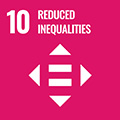- Docente: Maria Jesus Gonzalez Rodriguez
- Credits: 5
- SSD: L-LIN/07
- Language: Spanish
- Teaching Mode: Traditional lectures
- Campus: Forli
-
Corso:
Second cycle degree programme (LM) in
Intepreting (cod. 6057)
Also valid for Second cycle degree programme (LM) in Intepreting (cod. 6057)
-
from Oct 03, 2024 to Dec 05, 2024
Course contents
The 40-hour course will be delivered in the first semester (two classes per week). It envisages obligatory attendance of 70% of classes and of exercises with the lecturer (second semester).
The aim of the course is to improve students’ knowledge and skills acquired in the BA program, focusing on simultaneous and consecutive interpreting from Italian into Spanish. Special attention will be devoted to consolidating students’ theoretical and practical competence concerning prosody, lexicon, idioms, style, register, communicative modalities, paralinguistic features etc.) and expand their knowledge of different specialized sectors (economy, politics and international current affairs).
Practical exercises: introduction in interpreting techniques (Spanish >< Italian) and oral presentations will help consolidate students’ verbal fluency in Spanish, in both Iberian and Latin American variants.
Readings/Bibliography
BIBLIOGRAFIA CONSIGLIATA:
- Abascal, M.D. (2004). La Teoría de la oralidad, Málaga: Analecta Malacitana.
- Alcoba, S. (2000). La expresión oral, Barcelona: Ariel.
- Alcoba, S. (1999). La oralización, Barcelona: Ariel.
- Russo, M. (coord.) (2021). Interpretare da e verso l'italiano, Bologna: BUP. https://buponline.com/az13zg/uploads/woocommerce_uploads/interpretare-da-e-verso-italiano.pdf.
- San Vicente, F.; Bazzocchi, G. (coord.) (2021). LETI: Lengua española para traducir e interpretar, Bologna: CLUEB.
BIBLIOGRAFIA COMPLEMENTARIA:
- Amato, A.; Spinolo, N.; González Rodríguez M.J. (eds.) (2018). Handbook of Remote Interpreting - Shift in Orality, DOI:10.6092/unibo/amsacta/5955. [https://cris.unibo.it/retrieve/handle/11585/649648/388201/HANDBOOK%20SHIFT.pdf]
- Baigorri-Jalón, J. (2000). La interpretación de conferencias: el nacimiento de una profesión . De París a Nuremberg, Granada: Comares.
- Blasco Mayor, M.J. (2007). La comprensión oral en el desarrollo de la pericia de la interpretación de conferencias, Granada: Comares.
- Calsamiglia Blancaforr, H.; Tusón Valls, A. (2001). Las cosas del decir, Barcelona: Ariel Lingüística.
- Collados Aís, Á. (1998). La evaluación de la calidad en interpretación simultánea. La importancia de la comunicación no verbal, Granada: Editorial Comares.
- Morelli, M. (2010) La interpretación español-italiano: planos de ambigüedad y estrategias, Granada, Comares.
- Russo, M. (2012) Interpretare lo spagnolo. L'effetto di dissimmetrie morfosintattiche nella simultanea, Bologna: Clueb.
Altre indicazioni bibliografiche saranno fornite durante il corso.
Teaching methods
Lectures & practical exercises in the classroom, different types of discourse, written, oral, multimedia, will be used in the classroom, applying interpretive and descriptive specific categories, aimed at strengthening the cultural and linguistic competence of future interpreters.
Exercises (medium/high duration and difficulty):
- interlinguistic and intralinguistic rephrasing exercises (ITA>SPA, SPA-SPA)
- summarizing: listening, comprehension, memorisation and synthesis of oral texts or audio/video, isolating key concepts and logical connections (SPA-SPA)
- textual construction and improvising techniques starting with key elements, reconstruction of missing information (SPA-SPA);
- sight-translation (ITA>SPA)
- A short introduction note-taking (SPA-SPA, ITA>SPA)
Evaluation methods:
- self-evaluation
- students evaluation
- teacher's'evaluation
Assessment methods
Ongoing testing: oral presentation (+/- 5-6 minutes) about social-cultural, historical-social toppic (Spain, Latin America). A 500-word essay on the first subject discussed in class.
Written exam (2 hours) and oral exam (15 minutes). The written examination consists in exercices with 2 questions to answer on themes and topics covered during the course. Time allowed: 2 hours.
The oral examination (15 min.) consists in a discussion on themes and topics covered during the course, and students oral presentations with multimedia material (5-7 min).
A single final mark is given based on two components: a) written exam (0-30), and b) oral examination (0-30) with ongoing test-presentation and essay (+ 0-2).
Grading scale
30-30L: Excellent level.
27-29: good level. The candidate shows a solid command of the required skills and competences.
24–26: Generally sound level. The candidate displays significant shortcomings, indicating a reasonable command of the required skills and competences.
21-23: Adequate level. The candidate displays significant shortcomings and only an adequate command of the required skills and competences.
18–20: Minim level. The candidate only meets the minimum level required and shows a minimal command of the required skills and competences.
Teaching tools
Classroom equipped with computer and videoprojector. Audio, audio-video and printed material will be used in class (e-learning).
Teaching material: speeches delivered by Spanish-speaking politicians, representatives of humanities and science, both European and Latin American; press articles; Internet audiovisual material.
Learning platforms: Moodle/Virtuale.
Links to further information:
https://www.unibo.it/sitoweb/maria.gonzalez
Office hoursSee the website of Maria Jesus Gonzalez Rodriguez [https://www.unibo.it/sitoweb/maria.gonzalez/en]
Office hours
See the website of Maria Jesus Gonzalez Rodriguez
SDGs


This teaching activity contributes to the achievement of the Sustainable Development Goals of the UN 2030 Agenda.
